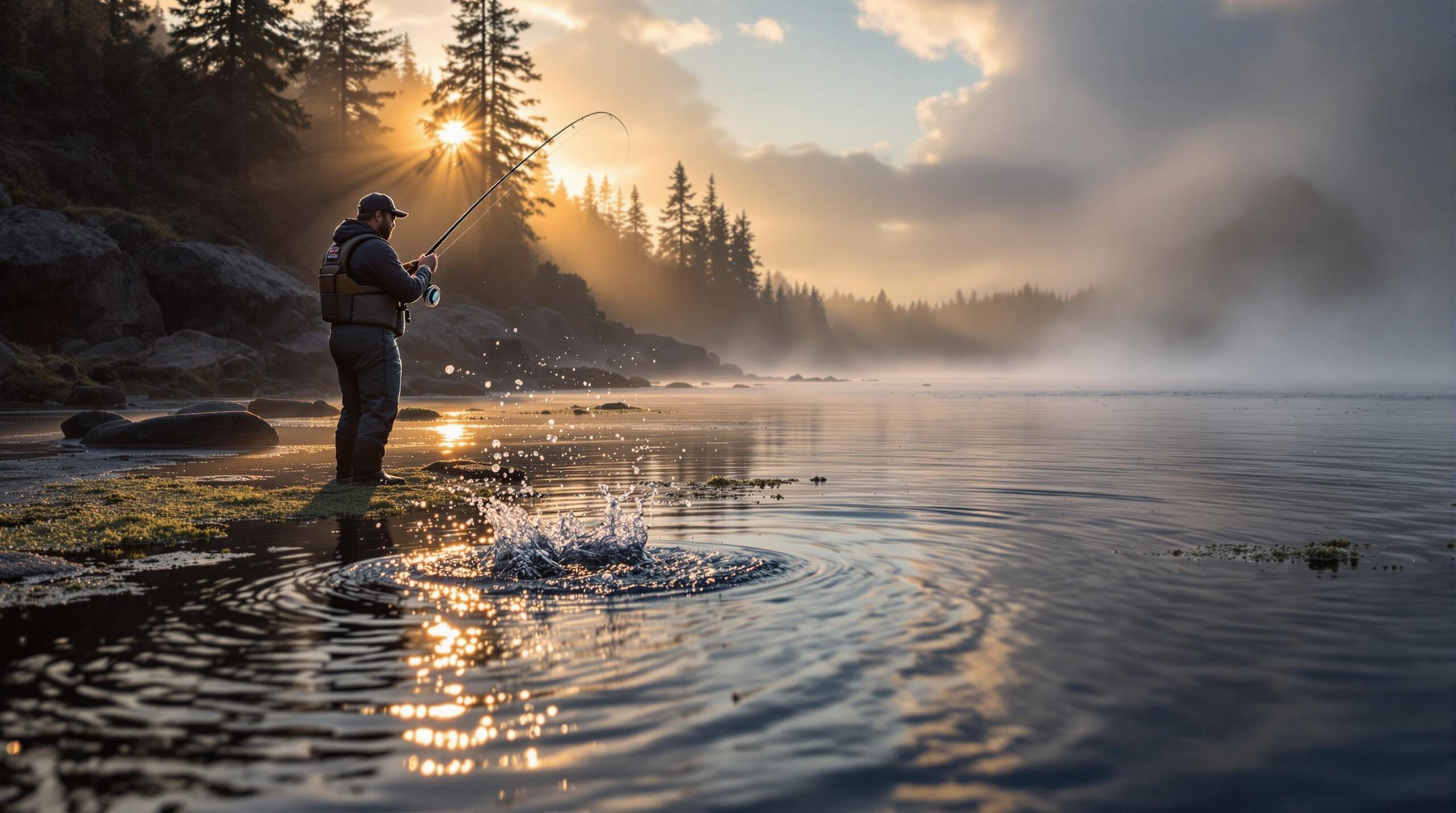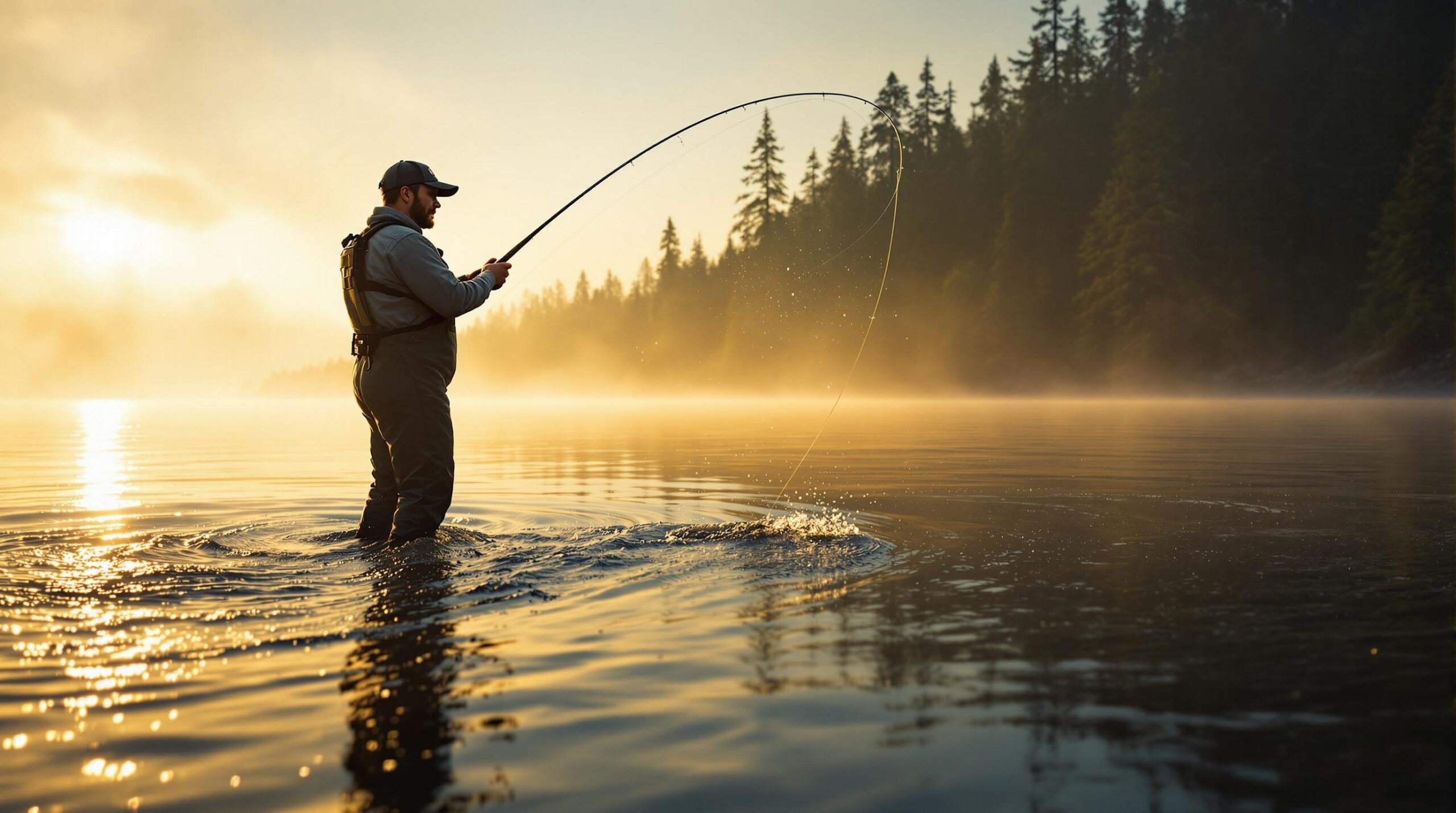According to the Washington Department of Fish and Wildlife, sea-run cutthroat trout populations in Puget Sound have increased by 25% over the past decade, making this one of the Pacific Northwest’s most rewarding yet underappreciated fisheries. Puget Sound fly fishing for these coastal gems offers anglers an opportunity to target a unique anadromous species that feeds in nearshore waters year-round.
Key Takeaways
- Sea-run cutthroat trout provide year-round fishing opportunities in Puget Sound’s protected waters
- These fish average 12-16 inches with occasional trophy specimens exceeding 20 inches
- Best fishing occurs during tide changes near kelp beds and rocky shorelines
- Small baitfish patterns and crab flies produce the most consistent results
- Beach access points throughout central Puget Sound offer fishing without boat requirements
Understanding Sea-Run Cutthroat Trout in Puget Sound
Sea-run cutthroat trout represent one of the most accessible gamefish species for Puget Sound fly fishing enthusiasts. Unlike their freshwater cousins, these anadromous fish spend portions of their lives in saltwater, developing different feeding behaviors and growth patterns.
The species measures between 12-16 inches, though specimens over 20 inches aren’t uncommon in productive waters. Research from the University of Washington School of Aquatic and Fishery Sciences indicates these fish can live up to eight years, with the largest individuals often being repeat spawners that have made multiple migrations.
Sea-run cutthroat differ from resident cutthroat in their appearance and behavior. Their silver coloration provides camouflage in saltwater environments. The red slash under their jaw becomes more pronounced during spawning periods.
Life Cycle and Habitat Preferences
These fish follow a complex life cycle that makes Puget Sound fly fishing exciting. Young cutthroat spend their first 2-3 years in freshwater streams before migrating to saltwater. Unlike salmon, they don’t die after spawning and can make multiple trips between fresh and saltwater.
During their saltwater phase, sea-run cutthroat inhabit nearshore areas where they feed on small fish, crustaceans, and marine invertebrates. They prefer depths of 10-40 feet and concentrate around structure like kelp beds, rocky points, and eelgrass meadows.
The fish remain in Puget Sound year-round, though their distribution shifts seasonally. Winter months see them in deeper waters, while spring and summer bring them into shallower areas where they’re most accessible to fly fishers.
Top Puget Sound Fly Fishing Locations for Sea-Run Cutthroat
Central Puget Sound offers numerous productive locations for targeting sea-run cutthroat. The protected waters provide consistent fishing opportunities regardless of weather conditions that might affect ocean fishing.
Lincoln Park in West Seattle stands out as one of the region’s most reliable spots. The rocky shoreline and adjacent kelp beds create habitat these fish prefer. The best fishing occurs along the northern point during incoming tides.
Point Defiance Park in Tacoma provides access to productive waters. The park’s shoreline offers multiple fishing opportunities, with the ferry dock area producing consistent results during tide changes.
Island and Peninsula Hotspots
Vashon Island’s eastern shore provides some of the most consistent Puget Sound fly fishing for sea-run cutthroat. The gradual dropoffs and abundant forage create conditions these fish seek. Quartermaster Harbor’s protected waters offer fishing during winter months.
Blake Island’s northern beaches produce strong results, during summer months when baitfish concentrate in shallow areas. The state park provides convenient access, though boat transportation is required.
Saltwater State Park offers easily accessible shoreline fishing with good success rates. The underwater structure and proximity to the Green River create a natural funnel for migrating fish.
Seasonal Patterns and Timing for Puget Sound Fly Fishing
Understanding seasonal movements improves success rates when targeting sea-run cutthroat. These fish exhibit predictable patterns that anglers can use for consistent results.
Spring brings the most active feeding as water temperatures rise and baitfish become abundant. March through May produces the best action, with fish feeding in preparation for spawning runs.
Summer fishing remains productive, though fish move to deeper waters during the warmest periods. Early morning and evening sessions produce the best results. The Washington state fishing opportunities extend well beyond cutthroat, making summer a good time for diverse angling experiences.
Fall and Winter Opportunities
Fall marks another peak period as sea-run cutthroat feed heavily before winter. September through November offers good fishing, with fish often found in shallow water chasing baitfish.
Winter fishing requires more patience but can produce trophy specimens. Fish concentrate in deeper areas but still feed during favorable conditions. Overcast days with light rain often trigger feeding activity.
Tide timing plays a role regardless of season. The two hours before and after tide changes produce the most action, with moving water bringing fresh food sources into feeding areas.
Fly Patterns for Puget Sound Sea-Run Cutthroat
Successful Puget Sound fly fishing relies on matching local forage species. Sea-run cutthroat feed on small fish, crustaceans, and marine worms, requiring specific fly patterns to achieve consistent success.
Clouser Minnows in size 4-8 represent the most versatile pattern for these waters. Olive and white combinations work well year-round, while chartreuse and white work during overcast conditions. The weighted design allows fishing at various depths.
Small Deceivers tied on size 6-10 hooks imitate juvenile salmon and herring. Pink and white combinations prove productive during summer months when young salmon are abundant.
Specialized Saltwater Patterns
Crab patterns deserve attention in every Puget Sound fly fishing arsenal. Size 4-6 tan and olive crab flies work well around rocky areas and kelp beds. The Mercer’s Poxyback Crab remains a regional favorite.
Euphausiid patterns target a food source that many anglers overlook. Small orange and pink shrimp flies in sizes 8-12 can produce strong results, during tide changes when these creatures move through the water column.
Candlefish patterns become important during winter months when these small fish concentrate in Puget Sound. Simple white and silver streamers imitate this important forage species.
Tackle and Equipment for Puget Sound Fly Fishing
Proper equipment selection impacts success rates and enjoyment when pursuing sea-run cutthroat. The saltwater environment and fish behavior patterns require specific tackle considerations.
A 6-weight rod provides the balance for most Puget Sound fly fishing situations. The rod should be 9-10 feet long to handle wind conditions and provide adequate casting distance. Fast-action rods help cut through wind and turn over weighted flies.
Floating lines work for most situations, though a sink-tip or intermediate line proves valuable for deeper water fishing. A 9-foot leader tapering to 8-12 pound test handles most conditions while providing adequate shock absorption.
Accessories and Gear
Waders allow access to the best fishing areas and comfort during extended sessions. Neoprene or breathable chest waders allow fishing from various beach angles and depths.
A large-capacity reel with a smooth drag system handles the strong runs these fish are capable of making. The reel should hold at least 150 yards of backing to account for long runs in open water.
Polarized sunglasses improve fish spotting ability and protect eyes from reflected glare. Amber or copper lenses work best in Puget Sound’s frequently overcast conditions.
Puget Sound Fly Fishing Techniques
Mastering specific techniques elevates success rates beyond basic casting and retrieving. Sea-run cutthroat respond to presentation methods that match their natural feeding behaviors and environmental conditions.
The strip-and-pause retrieve mimics wounded baitfish and triggers strikes. Vary strip lengths from short, quick pulls to longer, steady strips based on fish response. Pauses of 2-3 seconds often trigger strikes from following fish.
Depth control becomes important when fish are holding in specific water columns. Count down your fly after casting to reach the proper depth, then maintain that level throughout the retrieve. Understanding trout feeding patterns helps predict where fish will position themselves in the water column.
Reading Water and Structure
Successful anglers learn to identify productive water types and structure features. Kelp beds create natural ambush points where cutthroat wait for prey. Fish the edges and openings within kelp forests for best results.
Rocky points concentrate baitfish and create current breaks that cutthroat use for feeding. Focus on the downcurrent side of points where prey gets swept into ambush zones.
Current seams where different water masses meet often hold feeding fish. These areas concentrate food and provide energy-efficient feeding opportunities. Learning to recognize trout holding patterns in saltwater environments improves fishing efficiency.
Conservation and Sustainable Puget Sound Fly Fishing Practices
Protecting sea-run cutthroat populations ensures future generations can enjoy this fishery. Current regulations and conservation practices support healthy fish populations while providing angling opportunities.
The Washington Department of Fish and Wildlife has implemented specific regulations for sea-run cutthroat that balance conservation with angling opportunity. Current limits allow retention of two fish per day with a minimum size of 14 inches.
Many anglers practice catch-and-release to support population sustainability. Proper handling techniques include using barbless hooks, minimizing fight time, and supporting fish properly during photography and release.
Environmental Stewardship
Puget Sound’s marine environment faces various challenges that affect sea-run cutthroat habitat. Climate change, pollution, and development pressure all impact fish populations and their food sources.
Anglers can contribute to conservation by participating in habitat restoration projects, supporting clean water initiatives, and practicing Leave No Trace principles during fishing trips. Simple actions like packing out trash and avoiding sensitive vegetation help preserve fishing access and habitat quality.
Supporting organizations that work to protect Puget Sound’s marine environment creates long-term benefits for the fishery. Groups like the Puget Sound Partnership and Trout Unlimited work on habitat protection and restoration projects.
Weather and Seasonal Conditions for Fishing
Pacific Northwest weather patterns influence sea-run cutthroat behavior and fishing success. Understanding these relationships helps anglers plan productive trips and adjust techniques accordingly.
Overcast conditions often produce the best fishing, as reduced light levels encourage fish to feed in shallow water throughout the day. Light rain can improve fishing by increasing insect activity and reducing fish wariness.
Barometric pressure changes trigger feeding activity. Falling pressure before storm systems often creates good fishing conditions, while high pressure systems may require deeper fishing or different techniques.
Wind and Water Conditions
Wind direction and intensity affect both fishing conditions and fish behavior. Onshore winds can make casting difficult but often concentrate baitfish in nearshore areas. Offshore winds create calmer surface conditions but may push prey species away from shore.
Water clarity varies throughout Puget Sound and changes with weather conditions. Clear water requires more natural presentations and longer leaders, while stained water allows more aggressive approaches and brighter fly patterns.
Tide height and current speed influence fish positioning and feeding activity. Strong currents can make fishing challenging but often trigger active feeding as prey species are swept past ambush points.
Planning Your Puget Sound Fly Fishing Adventure
Successful trips require advance planning that considers regulations, access, and timing. Several resources help anglers maximize their time on the water and increase success rates.
Check current regulations before each trip, as rules can change seasonally. The WDFW website provides up-to-date information on seasons, limits, and any special restrictions for specific areas.
Tide charts become planning tools for targeting sea-run cutthroat. Plan trips around good tide timing, the two hours before and after tide changes. Consider how tide height affects access to fishing areas.
Access and Logistics
Many fishing locations require advance planning for parking and access. Popular spots like Lincoln Park can fill up during peak times, on weekends and holidays.
Consider transportation options for reaching fishing areas. Some locations require ferry travel or longer drives, making trip planning more complex but often rewarding with less fishing pressure.
Weather backup plans ensure productive trips even when conditions change. Identify multiple fishing locations with different exposures to wind and weather, allowing flexibility based on actual conditions.
Frequently Asked Questions
What’s the best time of year for Puget Sound fly fishing targeting sea-run cutthroat?
Spring months from March through May offer peak fishing, with active feeding fish in shallow waters. Fall also provides opportunities from September through November as fish feed heavily before winter.
Do I need a saltwater fishing license for Puget Sound fly fishing?
Yes, you need a valid Washington saltwater fishing license for targeting sea-run cutthroat in Puget Sound. Licenses are available online through WDFW or at sporting goods retailers throughout the region.
What fly patterns work best for sea-run cutthroat in Puget Sound?
Clouser Minnows in olive/white and small Deceivers prove most productive. Crab patterns work well around rocky areas, while euphausiid and candlefish imitations target specific forage during certain seasons.
Can I fish for sea-run cutthroat from shore or do I need a boat?
Shore fishing provides access to productive waters throughout Puget Sound. Many top locations like Lincoln Park, Point Defiance, and Saltwater State Park offer easy beach access for wading anglers.
What size rod and line weight should I use for Puget Sound fly fishing?
A 6-weight rod measuring 9-10 feet provides performance for most conditions. Floating lines work for shallow water, while sink-tip lines help reach fish in deeper areas during certain seasons.
Are there any special regulations for sea-run cutthroat in Puget Sound?
Current regulations allow two fish per day with a 14-inch minimum size. Always check WDFW regulations before fishing as rules can change seasonally and vary by specific location within Puget Sound waters.
Sources:
American Sportfishing Association – Economic Impact of Recreational Fishing in Washington State
Johnson, L. – Fly Fishing Pacific Northwest Salt Waters
NOAA Fisheries – Puget Sound Salmon and Trout Habitat Assessment
Puget Sound Partnership – State of the Sound Report: Salmon Recovery
Quinn, T. – Ecosystem approaches to salmonid conservation – Fisheries Management Today
Washington Department of Fish and Wildlife – Sea-Run Cutthroat Trout Status Report


